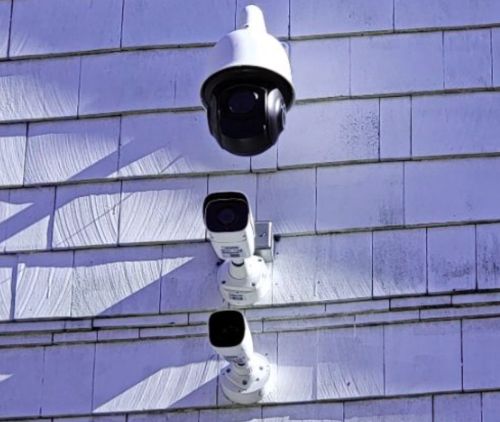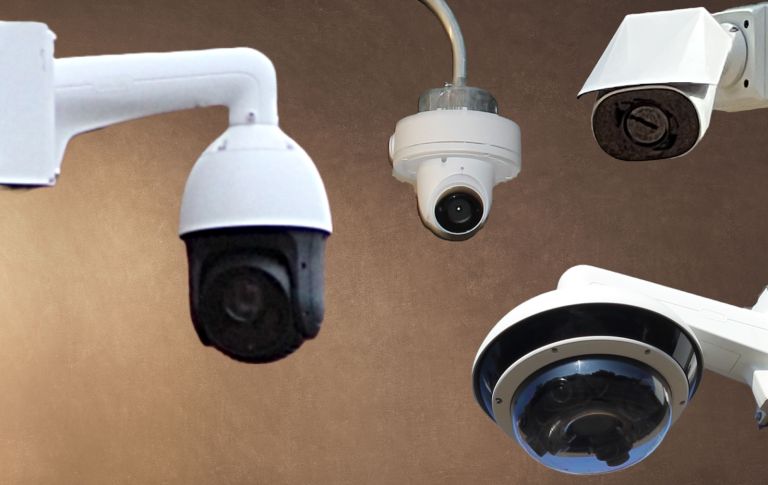Video MGMT System
 Access Control
Access Control
Voice & Data Wiring
 Burglar Alarm
Burglar Alarm
 Fire Alarm
Fire Alarm
Video MGMT System
Voice & Data Wiring
Mammoth Takeaways
PTZ (Pan-Tilt-Zoom) cameras can pan horizontally, tilt vertically, and zoom in or out—all while maintaining high-definition image detail.
PTZs provide this unusual level of flexibility and control because they feature motorized parts that respond to preset triggers and commands made via a browser or mobile app and physical remote controllers.
The correct use of a PTZ camera places it alongside overview cameras: the overview cameras provide continuous site coverage, while the PTZ is free to adjust its angle and zoom to capture detailed, close-up footage of moving objects or specific areas of interest.
Object tracking refers to a PTZ camera's ability to lock on and follow people and objects as they move.
A PTZ locks on its object by using artificial intelligence to identify its size, speed, and direction of movement. Once locked on, the camera pans, tilts, and zooms as needed to keep the object in its field of view.
Best Practice: Leverage artificial intelligence in overview cameras, facial recognition software, and integrated security devices to direct your PTZ to capture detailed, close-up shots of persons, cars, and other objects of interest. .
PTZ cameras are ideal for detailed close-ups and object tracking because their motorized lenses support optical zoom.
Optical zoom refers to the adjustment of a camera's zoom level via a process in which the lens moves toward or away from its image sensor. Optical zoom is superior to digital zoom because it provides high-definition or high-resolution footage of objects, whether distant or nearby.
Digital zoom merely magnifies part of an image without focusing to gather more detail. It often results in pixelation, an undesirable situation in which an image’s individual pixels are noticeable.)
As is the case with most IP (Internet Protocol) security cameras today, a PTZ’s video stream and many functions can be remotely accessed and managed via a desktop or smartphone app. However, PTZs stand out from other camera types because their motorized parts grant operators precise control over their field of view.
What's more, PTZs come with physical remote controllers and joysticks that don't rely on the Internet to communicate with the camera. Instead, PTZ remotes and joysticks communicate with their cameras using the same infrared technology as TV remotes.
Because slow or unreliable Internet access can result in long latency periods or wait times between the moment an operator makes a command and the moment the PTZ receives the command, infrared-based remote controllers or joysticks are often the most reliable tools for controlling PTZs.
The downside to PTZ remote controllers and joysticks is that, like TV remotes, they only function when in the same location as the devices they control.
PTZs can be programmed to respond automatically to triggers from the overview cameras they support. For example, an overview bullet camera installed to detect fence-line violations can trigger a PTZ to zoom in on and follow fence-line violators.
When connected with facial recognition software, a PTZ can automatically lock on and track a watchlisted individual.
Not only are PTZs able to collect highly valuable close-up evidence in this way, their motorized angle and zoom adjustments are often noticeable enough to deter bad actors.
PTZs can also be preprogrammed to adjust their field of view depending on factors like detected motion and the time of day.
When part of an integrated security installation, a PTZ can respond not only to AI-supported overview cameras but also to other security systems—such as those for threat detection and access control. For example, if an integrated motion sensor detects an anomaly or possible security breach, it can trigger an integrated PTZ to lock on, follow, and live stream footage of the offender.
PTZs are often placed in view of driveways, walkways, and entrance points to automatically capture clear footage of arriving persons or vehicles.

That said, a single PTZ is unable to track more than one person or object at a time. This means that if multiple guests were to simultaneously arrive at an entrance hall guarded by a PTZ, the camera would track the first guest it locks on and wouldn't track another until the first was out of range.
PTZs are well-suited to supporting overview cameras in parking lots, warehouses, concert venues, and other large commercial spaces. In such arrangements, the overview cameras provide general coverage while the PTZs focus on gathering important details.
PTZs are also useful in smaller settings, such as restaurants and retail establishments. By zooming in on areas like cash registers and entrances, they deter crime and capture evidence when incidents do occur.
Remember that total reliance on PTZs for surveillance will likely result in significant coverage gaps. After all, it's impossible for a camera to both closely track an object and provide comprehensive coverage at the same time.
A PTZ’s motion-based auto-tracking feature can monitor moving objects or individuals in low- and medium-traffic areas with little difficulty.
Only PTZs from premium camera manufacturers—such as Mammoth Security partner Avigilon—are recommended for object tracking in the busiest and most dynamic environments.
PTZs stand out from most other security cameras because their motorized parts provide users with precise control over their angle and zoom level. However, Internet issues can cause frustrating delays between the time a PTZ is given a command and the time it receives it.
For this reason, the use of a PTZ's infrared-based remote controller or joystick is recommended when on-site with the camera.
PTZs are some of the most expensive security cameras on the market, and their motorized parts leave them more vulnerable to malfunctions and general wear and tear than most. This expense alone is a good reason to limit PTZ use to support roles and functions that other cameras can't support.
Our team at Mammoth Security understands the how, the when, the where, and the why of security camera installation. Plus, we use our knowledge to help businesses and institutions like yours leverage various camera types (including PTZs) for comprehensive surveillance at the best possible price.

If you're ready for enhanced safety and asset protection at your property, contact the professionals at Mammoth Security today. Just fill out the simple contact form below, and we’ll quickly reach out to schedule your 100% free security consultation with a friendly expert from our team.
PTZ (Pan-Tilt-Zoom) cameras provide operators with remote control over panning, tilting, and zooming functions and are able to provide highly detailed views of specific objects or areas. They can lock on and track moving objects by leveraging motorized parts, and they're able to capture high-definition footage regardless of a tracked object's distance.
Unlike fixed-lens cameras, PTZ cameras provide users with optical zoom abilities. Optical zoom refers to the ability of a camera to flexibly zoom in and out of its field to capture detailed images. On the other hand, fixed-lens security cameras have an inflexible range of focus.
PTZ cameras can be controlled remotely via a desktop or smartphone app or physical remote controllers and joysticks using infrared technology. A single PTZ remote controller can be used to operate many cameras at once, making them especially useful when there are multiple cameras but only one operator.
PTZ cameras are versatile and can be used in various applications. However, for busy or dynamic spaces, top-quality PTZs from premium manufacturers, such as Avigilon, are recommended.

Wireless
IP Cameras
Wireless cameras are not reliable enough for commercial use yet. Instead, we use purpose-built antennae to connect hardwired cameras on light poles and buildings.

Phone App
For Camera Systems
Watch live or previously recorded footage on any mobile device. Save it to your phone and e-mail it just like any other video or image.

Increased Resolution
Of 4096×2160
4k or 8MP cameras represent the best value at the moment. Depending on your situation, a 30+ megapixel camera can be installed allowing you to read a seat number from the opposite end of a football field.

Employ The Same Technology As These Companies:


